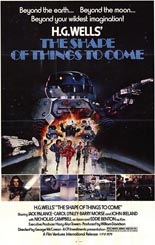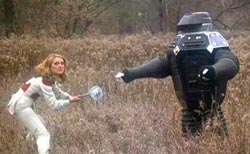
 After Star Wars changed the world, each part of that world wanted its own Star Wars. Italy cooked up Starcrash; Japan produced Message from Space; and Canada clocked in with H.G. Wells’ The Shape of Things to Come. Quite a mouthful, eh? Based in name only on Wells’ 1933 speculative novel, Shape is an all-around square effort (under)funded by schlock specialist Harry Alan Towers (Five Golden Dragons) and directed by Frogs’ George McCowan.
After Star Wars changed the world, each part of that world wanted its own Star Wars. Italy cooked up Starcrash; Japan produced Message from Space; and Canada clocked in with H.G. Wells’ The Shape of Things to Come. Quite a mouthful, eh? Based in name only on Wells’ 1933 speculative novel, Shape is an all-around square effort (under)funded by schlock specialist Harry Alan Towers (Five Golden Dragons) and directed by Frogs’ George McCowan.
A long time ago in a galaxy far, far away On the tomorrow after tomorrow, according to the opening crawl, people fled Earth after the robot wars left it polluted, and colonized the moon. It also tells us that we are dependent upon the miracle drug RADIC-Q-2, which is produced only on the distant planet Delta III.
 In and of itself, that is not necessarily a bad thing; the situation changes when Delta III ruler Omus (Jack Palance, Tango & Cash) decides to withhold 100 percent of the drug’s supply in order to blackmail the moon’s New Washington into making him supreme commander of the moon and Earth. Clad in a cape that makes Palance’s character look like an AARP-sponsored superhero (superpower: craps bigger’n you), he’s basically Big Pharma price hijacker Martin Shkreli. (Given that Shkreli was negative 4 years old at the time, the film indeed predicted Things to Come. Mind, consider yourself blown.)
In and of itself, that is not necessarily a bad thing; the situation changes when Delta III ruler Omus (Jack Palance, Tango & Cash) decides to withhold 100 percent of the drug’s supply in order to blackmail the moon’s New Washington into making him supreme commander of the moon and Earth. Clad in a cape that makes Palance’s character look like an AARP-sponsored superhero (superpower: craps bigger’n you), he’s basically Big Pharma price hijacker Martin Shkreli. (Given that Shkreli was negative 4 years old at the time, the film indeed predicted Things to Come. Mind, consider yourself blown.)
Powered by dated Honeywell computers, the senators of New Washington negotiate neither with terrorists nor past-their-prime matinee idols in the nadir phase of their career, so whereas viewers may expect a war among the stars, the battle instead is waged — per Towers’ iron grip on the pocketbook — on the farm pasture of Québec. Among those fighting the good fight against Omus and his boxy, walking robots with arms constructed from shop-vac hoses: The Dead Zone’s Nicholas Campbell, The Boogens’ Anne Marie-Martin (her hair lively with considerable, just-been-conditioned bounce) and The Poseidon Adventure’s Carol Lynley.
Effects for this sagging space saga run the spectrum, from quite nifty to rather embarrassing. Budgetary woes weep loudest in the practical settings and costuming, particularly spinning pound-cake pans used as a torture device and protective helmets that are nothing more than inflated plastic bags placed over the actors’ heads — both examples fine for Saturday-matinee fare of the ’50s, but hopelessly out-of-touch by the high-bar standards of the George Lucas generation. Perhaps worst of all, The Shape of Things to Come fails to connect narratively; if Towers jettisoned everything from the book but Wells’ title, why settle for a tale of politics? For every minute that limps by, those robot wars of the aforementioned crawl sound all the more appealing. What we were given can be summarized by a line uttered by Campbell after experiencing Shape’s no-frills version of 2001’s famed stargate sequence: “What the hell was that all about?” —Rod Lott
